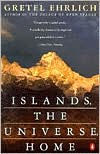My friend Laura recommended Ehrlich’s work to me, and I enjoyed Ehrlich’s novel, Heart Mountain. However, this collection of essays is truly stunning. In the things of her world Ehrlich finds tangible evidence for the thoughts and ideas jostling in her head, anchoring them to coherence.
Her world is primarily her ranch in Wyoming, its five-acre lake, the nearby mountains. In the short essay that opens the book, “Looking for a Lost Dog”, she starts by grounding us in concrete action: “I started off this morning looking for a lost dog.” She uses a couple of sentences to bring the dog to life, with the surprising image of a saddleshoe to describe his markings and the quick sense of ranch life from learning that his right front leg is crooked because it froze to the ground on the thirty-below-zero night he was born. Clearly the stakes are high in this environment.
Then she tells us, “I walk and I listen.” This is a good description of her modus operandi throughout the book and, indeed, for the essays that I have most loved, like Barbara Hurd’s Stirring the Mud and Annie Dillard’s Pilgrim at Tinker Creek. These writers combine close attention to the natural world with fragments of information and memory, not randomly thrown together, but carefully crafted to challenge us to open our minds. What we take away from this mosaic may be different for each of us.
Ehrlich in this essay never strays far from her concrete experience. She remembers another time when the dog was lost, and she found him by putting her ear to the ground to listen for him whining. This leads to thinking about what the construction of our ears, their limited range, says about humans, and the memory of a musician friend talking about the music of the world, “’the great suspiration of life everywhere.’”
But then she goes back to her search and describes the falls she heads towards, the raven overhead. From then on, she leaves the narrative only for a paragraph, a sentence, but each digression adds another dimension to the experience. We have all looked for what is lost, and sometimes tried to lose what has been found. Living through this essay awakened echoes in me, that resonated with the images she conjures up, deepening into chords, creating a new and strange music.
Many of the other essays in this book also take events on the ranch as their starting place. It is a life closely tied to the weather, as her explorations of the permutations within each season make clear.
It’s spring again, and I wasn’t finished with winter. That’s what I said at the end of summer too. I stood on the ten-foot-high haystack and yelled, “No!” as the first snow fell . . . It’s spring, but I was still cataloguing the different kinds of snow: snow that falls dry but is rained on; snow that melts down into hard crusts; wind-driven snow that looks blue; powder snow on hard pack on powder . . .
Other essays take us further afield: a search for the source of the Yellowstone River, a trip to Japan to follow in Bashō’s footsteps, a visit to the Santa Barbara Channel Islands to learn about the Chumash, a culture and language pulled back from the brink of vanishing by the work of a few dedicated people. I’d never heard of the Chumash before.
For eight thousand years or more, the Chumash lived in isolation and peace. One of at least sixty tribal groups in California, they once numbered fifteen thousand. They had no neighboring enemies and no warrior cult.
Their beliefs, their history, their experiences after being discovered are seamlessly integrated into Ehrlich’s journey to San Miguel, known to the Chumash as Tuqan.
In all of these journeys, Ehrlich’s gives her close attention to her immediate experience while layering in information, quotations, and feelings. Whatever conclusions she may have reached, whatever overall pattern she has found, Ehrlich does not force a lesson on us. We are left to draw our own conclusions from sharing her journeys. As she says in the brilliant first essay about searching for her lost dog, “I walk with a purpose but no destination.” Whatever destinations we find in these essays come from the resonances between the pieces of her mosaic and the echoes they call up in our own hearts.
What have you learned from the natural world?

